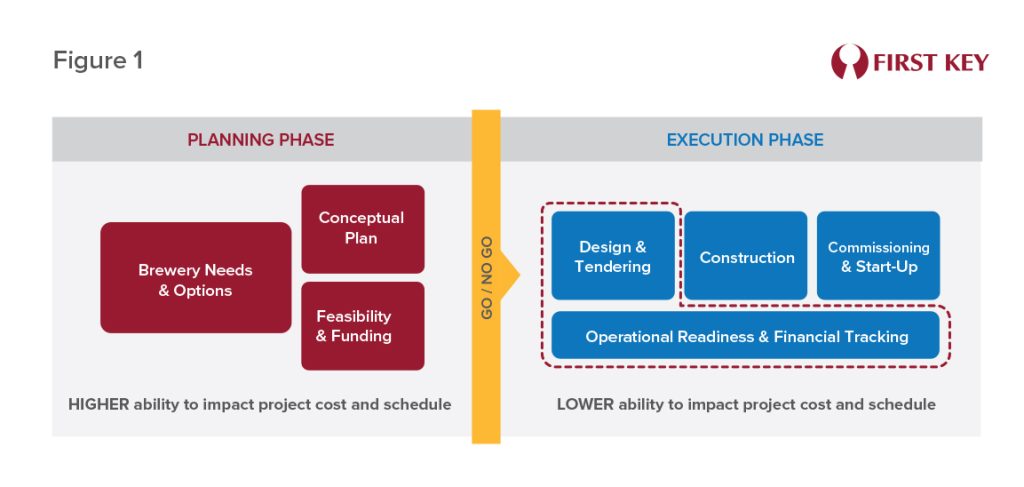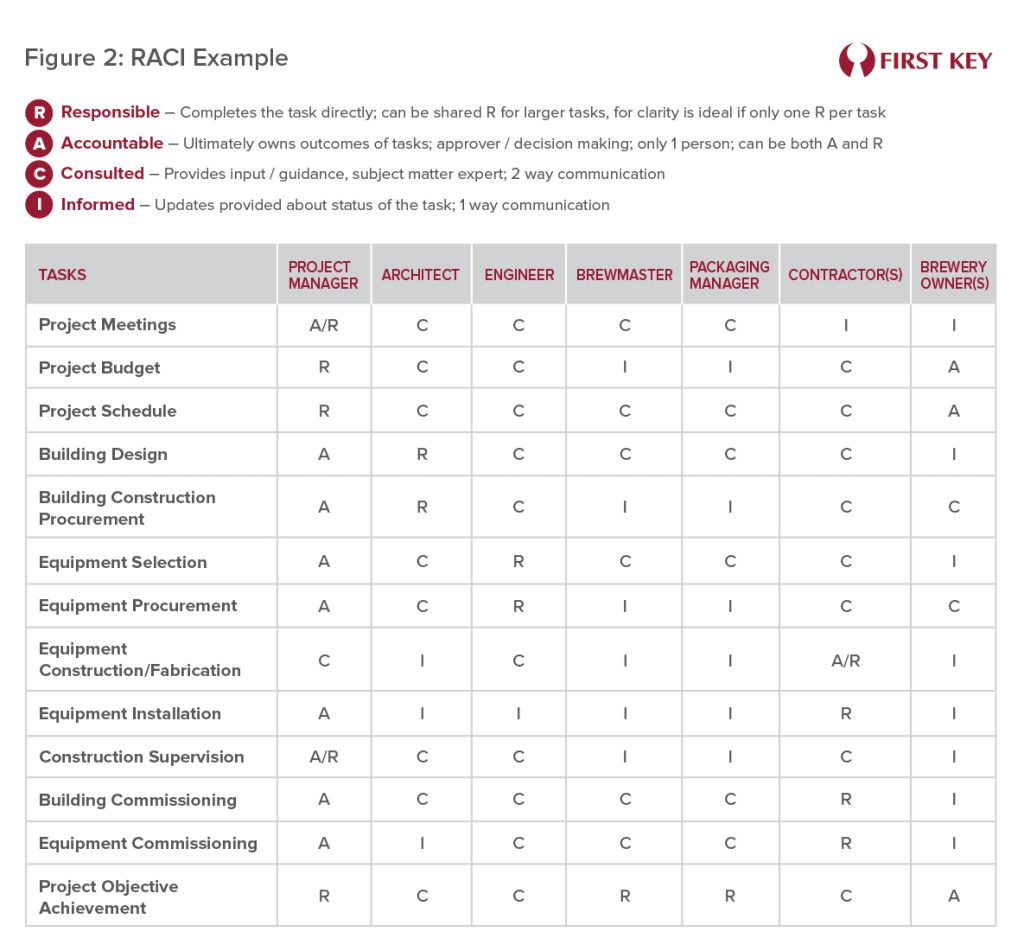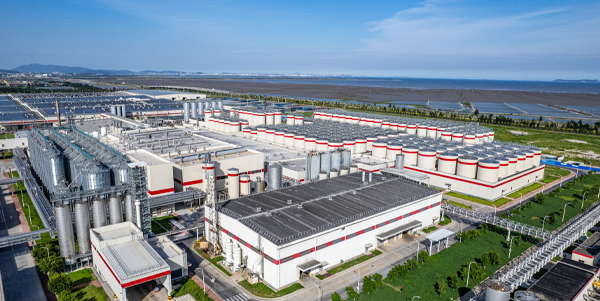Your decision has been made to move forward with a major project at your brewery. This is an exciting, although daunting, time which can be filled with uncertainty – now what?
What are the next steps?
Who should be involved?
When and how to start the project?
How will project implementation impact the brewery?
How will project progress be reviewed and adjustments made?
To get to a Go/No Go Decision Point, a high level roadmap for project success as defined in The Planning Phase should already be in place. If some of the critical steps of the Planning Phase have not yet been completed, it is important to invest the time and resources now to ensure the project is set up properly prior to getting too far into the Execution Phase. Figure 1 details the overall Project Management Approach and highlights the importance of planning out the project well, such that higher costs and wasted time due to project changes within the Execution Phase can be avoided. This article will provide insights into the early aspects of the Execution Phase.

Establishing the Project Team and its Routines are Critical Early Steps
Focus from the start on establishing the brewery’s readiness to support the project’s implementation, and on having the right project team focused on the project. These are essential aspects to be detailed and implemented with reference to the Resource Planning step in the Planning Phase.
The Project Team
The Project Manager’s time and efforts will need to be focused on the project implementation to ensure success, but they can’t do it alone! Day-to-day project leadership will come from the Project Manager, but it is important that many other stakeholders be actively engaged. A helpful tool to determine who should be involved and how all project team members will work together is the RACI tool. An example of the use of the RACI tool is shown in Figure 2, which outlines key tasks for the project against internal and external resources available to the brewery. Defining who is Responsible, Accountable, Consulted, or Informed for each task will make actions and expectations clear. Defining the Accountable vs. Responsible role for each task is typically the most difficult but also the most important aspect of planning task execution. The Responsible role is the person who will actively and directly complete the work. The Accountable role is the person who has overall ownership for the outcome of the task but does not directly complete the work. It is best to assign both Accountable and Responsible roles as far down in the organizational structure as possible to ensure the work is completed with the right expertise, ability, and detailed knowledge to complete the task properly. Using a RACI model can be very helpful at streamlining complex work plans or projects as the tool visualizes clear assignments for each of the team members.

Project Routines & Communications
Just like many other aspects of the brewery, creating a routine for consistent follow through during project execution is key to success. Setting up recurring Project Meetings is a simple but critical way to ensure the project gets the focus it needs. Meeting frequency should be set based on the size and impact of the project. Many breweries choose to meet often, setting weekly or bi-weekly meeting schedules to ensure critical tasks are being achieved according to the project schedule. Projects are being executed to achieve some major objectives for the brewery, so keeping progress on track and constantly pushing for action completion is essential to ensure these objectives are achieved. Keeping meeting days/times/durations consistent is an easy and effective way to make the project a priority and part of the norm for the project team members, who also have many other competing priorities at the brewery. This consistency can be supported by setting up a standard agenda template for each meeting and establishing a clear action list or minutes from each meeting to ensure those responsible for updates or action completion deliver on their responsibilities between meetings. Think of the project like you think about production at your brewery: if the project gets behind or begins to run off budget, this must be identified as quickly as possible so that it is corrected to achieve the objective at the end of the line. The project can’t short ship!
Communication within the project team (and with other key stakeholders) can be overwhelming. It is important to define these communications methods and expectations upfront and make updating and distributing this information as efficient and meaningful as possible. An easy and simple way to support communication is to create a centralized project file which includes a “dashboard” view of the key project measurables. This dashboard can be used as a great 1-pager update for higher level messaging (e.g. for the brewery owner or its investors) along with providing a quick “project health scorecard” for the more active members of the team. Feeding this dashboard view should include the project schedule, budget, key process metrics and action list which are being used to run the project. The detailed files will be more applicable to the departmental managers or technical consultants/experts on the project team who are more involved on a day-to-day basis. The biggest take-away is that communication to all stakeholders is important but intentional setup of files and project information management can make this communication effective and efficient. This is also a helpful way to stay organized and have an accurate “pulse” of the project’s progress and the critical next steps.
“The 3 key elements to any project are: Budget, Schedule and Scope. Setting up tracking mechanisms for each of these elements from the start will streamline communication throughout the project. Nobody wants a surprise at the end of the project!” says Rod Waite, Director of Engineering Services at First Key.
Transitioning from Conceptual to Detailed Design
From the Planning Phase, a decision to move forward may have been made with some options or alternatives still left to be finalized. In fact, no conceptual design will be perfect and will require further development and detailing to get it ready to execute. This could include various equipment layout options based on different equipment manufacturer offerings or different project plan options based on available space, financial resources or phased impact to production.
As part of the team, a project may require external resources like an architect to support building design modifications or engineers to design systems, select equipment, or review utility processes to support the project scope and its objectives. These consultants are helpful experts to translate high level ideas or concepts into detailed designs and plans. Some aspects of the project may require permits, licenses or other approvals from external authorities (e.g. building permits or pressure vessel certifications). These approvals usually require formal documentation and the necessary time for review by the authority, so they are important processes to start quickly after the project Go decision is made.
A Case Study
As an example of the transition from high level to detailed plans, a brewery’s conceptual project plan suggested that 8 additional fermenters, 3 additional bright beer tanks (BBTs), and a higher speed can line were needed to achieve future volume projections. The conceptual plan had a high-level layout drawing, budget and schedule defined as part of the Planning Phase.
As the detailed design progressed, it was determined that the concrete slab in the brewery where the tanks were planned to be located was deemed to be unable to support the point loads of the tank legs and the area had insufficient slope to drains. An architect was added to the project team to provide a specification drawing for the footings needed to support the tanks along with a design on how to rework the slab in the area to ensure proper floor drainage to reduce slip risks and overall hygiene. Some anticipated building modifications were budgeted as part of the conceptual budget, so these details aligned with the high-level projections, although the specifics weren’t fully understood when the project was approved.
The 3 large BBTs were part of the conceptual design but after further review, it was determined that there would be an access issue due to the limitations of the existing garage door size and aisle widths within the brewery to get the tanks into the selected location. Alternatives were explored to address this issue with 2 final considerations compared for total cost and schedule impact as the deciding factors:
- opening an exterior wall near the tank location, or
- modifying the tank dimensions to allow for rigging in the existing doors and aisles.
The project manager reviewed the situation with the project’s architect and the engineer, and it was determined that it was best to temporarily open up the exterior wall and rig the 3 larger tanks in that way since available footprint was at a premium and the cost of additional tanks to achieve the same BBT capacity was greater than the extra cost to temporarily open up the wall. This detailed design change pulled contingency funds from the budget since this detail was not identified during conceptual design, and this was now determined to be the optimal solution given the limitations. This is a great example of the type of detail that can come up as the design gets finalized and why it is important to include some contingency funds in conceptual budgets. During the conceptual phase of a project, contingency funds will need to be larger and should be reduced as the project phases progress since more certainty will be gained with the more detailed project scope, schedule, and execution plan.
As for the higher speed can line, the project team determined through a detailed packaging line V-curve analysis that the current can line had equipment downstream of the filler that was already well sized to support a higher speed filler and empty can supply equipment. This allowed the project to phase the upgrade of the can line in a more surgical way to reduce the total amount of production downtime required for equipment installation and commissioning, and it also reduced total capital cost for the project as it avoided the needless purchase of new downstream filler conveyers, a new packer, and palletizing equipment.
As it is said, “the devil is in the details” and the above Case Study shows that as the details of a project are firmed up, they can either yield positive or negative impacts to the budget, schedule, or scope. This also reinforces what is shown in Figure 1 of the importance of catching these types of details as soon as possible to provide a higher ability to mitigate the impacts of any changes. Experience will aid project managers to consider more aspects during conceptual planning without the time and cost investment of getting into the detailed design too early. Involving engineers, architects or experts during the Planning Phase for conceptual guidance can also provide less experienced project managers with support to improve the concept plan.
Procurement & Tendering
Once a detailed design is completed, the type or even model of equipment that should be purchased, and who and how it should be installed, will become clear. The Project Manager will then need to translate the detailed design into a Procurement Plan to break the design into a series of contracts for equipment purchase orders, construction and support services.
There are various approaches to procurement and tendering, and the path forward will differ significantly by brewery size, location, experience, and previous partnerships. Procurement approaches vary, with one option being a “Turnkey” approach where one vendor is awarded to supply, install and startup, such that this vendor will cover the full project scope. Another option is to use a more segmented approach where the Project Manager will coordinate a series of more specialized contracts to accomplish the project objectives. Either approach can be successful, and the best approach depends on many factors including the brewery’s procurement policies, the project team’s level of experience, the scale or scope of the project, etc. First Key can provide more guidance and support for procurement strategies as this topic is quite extensive. The overall goal of any procurement approach is to achieve the project objectives at a fair and competitive price with the required project schedule milestones.
Regardless of the approach, it is important that the tenders or contracts for the project clearly document the expected requirements, responsibilities and quality performance outcomes by each contractor. Some examples of the details to include in a tender document include:
- Clear, detailed scope of work and specifications to ensure that potential bidders have a complete understanding of the project and their scope boundaries.
- Drawings to help outline the project scope where words can’t adequately describe it.
- Detailed schedule and milestones.
- Construction phasing and tie-in details.
- Regulatory and safety requirements.
- Legal terms and conditions of the contract.
- Detailed deliverables from each bidder so that their quotation or bid document can be compared and the bidder’s understanding and adherence to the tender is fully documented.
The project team should evaluate all the quotations or bids carefully as these contractors and suppliers will become part of the project team. Nothing is more important to the project’s success than the function of the project team itself, so it is critical to ensure that all contractors will work constructively and collaboratively and will be responsible for their commitments to the overall project objectives. In evaluating each bid, the project manager should ensure that expertise is at the table with enough knowledge of operations, equipment and technological advancements so that the best option is chosen to meet the brewery requirements. Comparing the bids on a level playing field including scope, quality, performance guarantees, timelines, safety, etc. so that the total cost of ownership is considered thorough this analysis. Without this expertise involved in the tendering process, breweries can be misled or make decisions that don’t consider the full impact of the equipment supply or service contract which could limit the flexibility, scalability, efficiency, and serviceability of the deliverables. Navigating these decisions can be challenging so it is important to validate and complete the proper due diligence.
Like the Planning Phase, the early aspects of the Execution Phase of any project are all about being intentional, proactive and focused on the project objectives. This article is part of series from First Key on Project Management Best Practices. The next article will focus on The Construction Phase & Managing Brewery Operations with Ongoing Construction.



